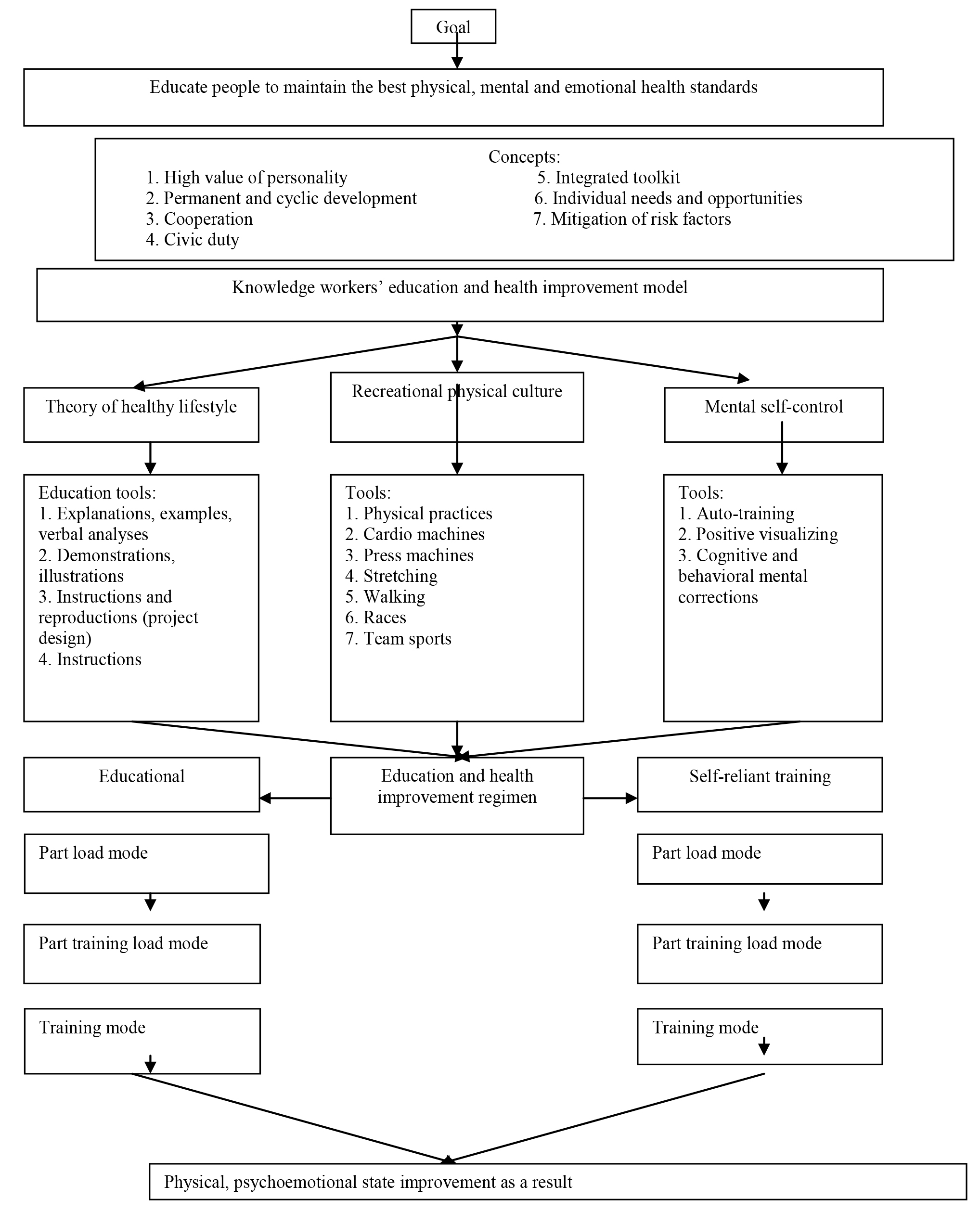Effects of fitness and body conditioning method on students' physical development and stress tolerance
Фотографии:
ˑ:
Dr.Med. T.A. Shilko1
T.P. Prokopets2
Dr.Hab. V.L. Krainik3
1National Research Tomsk State University, Tomsk
2Scientific and Research Institute of Cardiology of Russian Academy of Sciences, Tomsk
3Altai State Pedagogical University, Barnaul
Keywords: health education and improvement activity, model, knowledge worker.
Background. Modern socio-economic challenges faced by the sector are addressed, among other things, by more stringent requirements to the specialists’ physical performance and fitness to secure high professional standards including: good health on the whole, excellent intellectual performance based on good nervous, cardiovascular, visual and auditory system functionality, high intellectual work capacity, stamina etc. [2].
Many researchers note, however, that more than 60% of the knowledge workers in the sector are tested with low competitive working capacity, professional mobility and stress tolerance rates due to a variety of health disorders [1, 4]. This is the reason why a growing priority is given to innovative education and health projects geared to improve the specialist’s health protection and disease prevention system via modern physical education, motivating for a healthy lifestyle and conscientious responsibility for own health.
Objective of the study was to develop an education and health improvement model for knowledge workers and test its benefits by an educational experiment.
Methods and structure of the study. The study was designed to employ the following methods: analyses and summaries of the available theoretical and practical literature on the subject; educational process monitoring; questionnaire survey; functionality tests; and educational experiment. Subject to the study were 183 female knowledge workers of 28-65 years of age including an Experimental Group (EG) of 118 people and a Reference Group (RG) of 65 people. The experiment was designed to obtain the following test data: cardiovascular, muscle and respiratory system functionality rates; psychoemotional state rates to diagnose depressions, state and trait anxiety and frustration related conditions etc.
Study results and discussion. Having analysed the cardio-respiratory system functionality in the EG versus the RG, we diagnosed health disorders in most of the sample, with HR of 80+ beats per min at relative rest tested in 82% of the RG and 77% of the EG; unhealthy HR growth under exercise like going up the stairs to the 4th floor, with the HR tested to rise by 75% and 73% in the RG and EG, respectively, versus the norm of 30-50%. The blood pressure was also found to grow, with the systolic blood pressure (SAP) tested to grow to 140-160mm Hg in 58% and 67% of the RG and EG, respectively. The respiratory system functionality rated by the peakflowmetry was tested below the norm in 68% of the RG and 77% of the EG.
Furthermore, the RG was tested with a variety of psychoemotional conditions including: 61% of the group diagnosed with an increased trait anxiety; 88.24% with an average-level depression; and 47.06% with high frustration rates. The EG was much the same in the tests, with 50.94% of the group diagnosed with an increased trait anxiety; 69.81% with an average-level depression; and 67.92% with increased frustration rates.
The study data and analyses of the physical and psychoemotional state rates of the sample were applied to design an integrated health improvement model. The model may be described as the education and health improvement system geared to help the trainees master the relevant self-reliant trainings to maintain their physical fitness, psychoemotional state and health standards: see Figure 1.
The model is based on the following basics: high value of a personality; permanent cyclic self-development; due educator-trainee cooperation; civic duty (responsibility for own health); integration of relevant educational, medical, mental and physical conditioning tools; focus on the personal needs and opportunities; mitigation of the risk factors related to unhealthy nutrition, inactivity, smoking, alcohol addiction, personal anxiety, depression, stresses, negligent attitudes to own health, other people and life on the whole [3].
The education and health improvement model implies three physical education modules different in their goals, content of theoretical, physical and psychocorrectional tools, educational methods and physical practices, their design and content.
The health improvement physical tools applied in the model were customized to the education and health situations of the trainees, with the part load modes dominated by respiratory practices, morning exercises, self-massage, body conditioning practices, active outdoor walking practices (2-3 km per day with the rate of 70-80 steps per min).

Figure 1. Knowledge workers’ education and health improvement model
The part training load mode includes: a set of musculoskeletal system developing exercises; gymnastics for joints; body conditioning practices with appliances (sticks, balls, hoops, fitness balls etc.); cardio-system training tools; dosed walking 4-5km a day at the speed of 70-80-90 steps per min; team sports; relay races etc. And the training mode includes: body conditioning practices with dumbbells; rhythmic gymnastics; jogging; cardio machines; press machines for different muscle groups; walking 8-10km a day; stretching exercises; swimming in pools; skiing; and body tempering practices.
The psychocorrectional tools under the model are designed to provide a basis for new positive thinking models to facilitate the health improvement and self-progress based on the relevant positive cognitive-behavioural correction techniques designed to help perceive the negative mindsets and inadequate behavioural models provoking different health disorders.
The educational experiment to test benefits of the new education and health improvement model took one year with two 1.5-2 hours-long trainings per week, with a two-month break when the EG trainees continued practicing on their own. The RG was trained for 30-40 min twice a week, with the trainings including gymnastics, training-simulators-assisted practices and controlled walking). The primary tests failed to show any statistically significant difference between the EG and RG in the physical fitness and psychoemotional state rates (р>0.05).
Our study data and analysis showed benefits of the new education and health improvement model as verified by the EG versus RG knowledge workers’ significant progress in rehabilitation and working ability rates. Thus, HR was tested to improve by 17.4% from 81±1.31 to 68±1.22 beats per min (р<0.05); blood pressure tested to fall from 146/94 mm Hg to 125/83mm Hg (р<0.001). Furthermore, we found statistically significant progress (р<0.001) in the respiratory system performance rates, with peak-flow rates tested to improve from 334±10.16 to 509±10.22 l/min (41.4% growth). The breath-holding tests during inspiration showed progress from 33.69±1.07 to 60.09±1.52s (56.3% progress) and the breath-holding tests during inspiration - from 24.03±0.71 to 45.69±1.99 s (62.1% growth). The race test showed that the EG covered 495.37±13.61m for 6 min with the HR of 129.86±0.83 beats per min (р<0.001). The upstairs walking post-experimental tests showed the EG progress of 46.4% (р<0.001). The psychoemotional state (post- versus pre-experimental) tests showed significant progress of the EG (р<0.001) with the relevant personality progress rates. Thus the depression was rated to fall by 48.4% from 14.92±0.71 to 9.11±0.46 points during the experiment. The EG state anxiety was tested to fall from 33.67±1.03 to 24.84±0.72 points (30.2% progress); and trait anxiety was tested to decrease from 44.83±0.75 to 37.16±0.92 points (18.7% progress); and frustration rate was tested to fall from 2.56±0.06 to 1.88±0.06 points (30.6% progress).
Conclusion. The study data and analyses show benefits of the new integrated knowledge workers’ education and health improvement model as verified, among other things, by timely diagnosed and corrected physical and mental conditions. Based on the new knowledge and competences in the self-control and disease prevention physical practices, the trainees showed progress in the self-reliant healthy lifestyles, physical and spiritual progress for the personality development and life quality improvement.
References
- Ivanova E.V. Razvitie koordinatsionnykh sposobnostey u zanimayushchikhsya ekstremalnymi vidami deyatelnosti [Development of coordination abilities in athletes engaged in extreme activities] Psikhopedagogika v pravookhranitelnykh organakh, 2008, no. 2, pp. 18-19.
- Karyakina S.N., Maslyaninova O.M. Professionalny stress pedagogov gorodskikh i selskikh shkol [Professional stress of teachers in urban and rural schools]. LAP Lambert Academic Publishing GmbH & Co. KG Dudweiler Landstr. 99, 66123 Saarbrucken, Germany, 2012,131 p.
- Lyakh V.I. Koordinatsionnye sposobnosti: diagnostika i razvitie [Coordination abilities: diagnostics and development]. Moscow: Divizion publ., 2006, 290 p.
- Selye H. Stress bez distressa [Stress without distress]. Moscow: Progress publ., 1979, 124 p.
- Shil'ko V.G., Shil'ko T.A., Potovskaya E.S. Vliyanie fizkulturno-sportivnykh zanyatiy na pokazateli stressoustoychivosti studentov [Relationship of physical education and sport sessions and stress tolerance indices of students]. Teoriya i praktika fiz. kultury. 2016, no. 10, pp. 91–92.
Corresponding author: vshilko@mail.ru
Abstract
The study offers and analyses benefits of the knowledge workers’ health education and improvement model based on the concepts of genuine personality values, persistent progress and developmental cyclicality supported by prudently combined health tools customisable to individual needs and capacities with due provisions against potential risk factors. Subject to the study were 183 female knowledge workers of 28 to 65 years of age split up into an Experimental Group (n=118) and Reference Group (n=65). Every subject was tested to obtain cardiovascular, muscular and respiratory system functionality rates and psychoemotional state rates by the relevant depression, state and trait anxiety and frustration rating tests.
The study data showed benefits of the knowledge workers’ health education and improvement model as verified by the physical, mental and emotional progress rates achieved by the EG, the progress being further supported by the initiatives to build up the relevant knowledgebase, understanding of the self-control mechanisms and disease-prevention and health building effects of the physical practices associated with physical and spiritual personality progress and life quality improvements.




